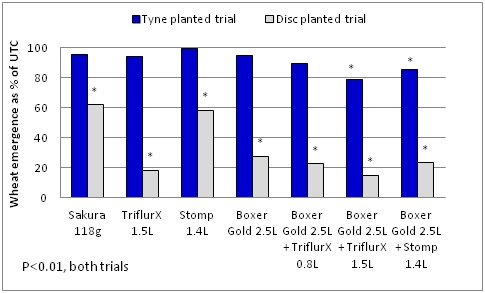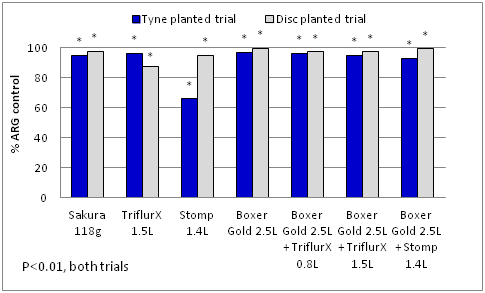Pre-emergent herbicides part of the solution but much still to learn
Author: Richard Daniel and Anthony Mitchell, Northern Grower Alliance | Date: 05 Mar 2014
Varieties displaying this symbol beside them are protected under the Plant Breeders Rights Act 1994.
GRDC code: NGA00003, GRDC Grower Solutions for Northern NSW and Southern Qld
Authors
Richard Daniel and Anthony Mitchell, Northern Grower Alliance
Take home messages
- The use of a disc planter for incorporation by sowing (IBS) of residual herbicides resulted in significantly reduced wheat emergence for all four herbicides evaluated
- The disc planter ‘set-up’ actually increased the risk of crop damage
- These results reinforce the need to only use narrow point tynes when using residual herbicides with IBS recommendations
The issue
The widespread adoption of minimum tillage has provided many agronomic and sustainability benefits to our farming system. However it is a system that has led to an over-reliance on knockdown herbicides to achieve effective weed management. As a consequence we are faced with management issues in two main ‘herbicide-driven’ scenarios; control of herbicide resistant weeds e.g. annual ryegrass (ARG) and selection of weed species with higher levels of natural herbicide tolerance e.g. feathertop Rhodes grass.
Residual herbicides are an important tool to assist in the control of weeds in both these scenarios but the issues that have always dogged residual products will be important to better understand and manage e.g. consistency of efficacy across varied soil types, incorporation requirements and stubble loadings, plantback restrictions and how to best maximise crop safety without reducing weed efficacy.
This paper deals with results from two trials conducted in 2013 evaluating the crop safety and efficacy of registered residual herbicides for the control of ARG in wheat.
The majority of treatments were managed by the incorporation by sowing (IBS) approach. IBS specifies the use of narrow point tynes on the planting equipment. This approach helps to ensure sufficient soil is thrown across the inter-row space to effectively ‘incorporate’ the herbicide, plus it removes most of the herbicide treated soil from the planting furrow to improve crop safety. The negative consequence is that IBS generally provides poor weed control in the zone immediately around the planting row. In many cases, post sowing pre-emergent application (PSPE) is also being evaluated as it provides more uniform weed efficacy but requires herbicides or rates with improved crop safety together with reduced incorporation characteristics.
What was done?
At a site near Mullaley NSW, the grower had adjoining paddocks which he intended to plant with the same wheat variety (Crusader ) but with two different planters; a tyned planter in one paddock and a single disc in the second. The trials were located within ~300m of each other.
) but with two different planters; a tyned planter in one paddock and a single disc in the second. The trials were located within ~300m of each other.
Both trials were sprayed and planted on the 20/6/13, with a single tank of each treatment used to spray both trials. Planting occurred immediately after herbicide application.
Soil type
Although the two trials were located within 300m of each other, there were distinct differences in the soil type. The soil type where the disc planter was used was a black vertosol with the tyne planter used in a lighter red soil.
Rainfall
The site had good planting moisture with ~48mm of rain received in the three weeks prior to planting. Table 1 shows the rainfall received between planting and the assessment of crop establishment, three weeks after planting. There was a total of 31 mm received in the first 9 days after planting. The only rainfall in the first week after planting was 4mm on day 4. It was not considered that this level of rainfall would have created a high risk scenario.
| Date (days after planting) | 24/6 (+4) | 27/6 (+7) | 28/6 (+8) | 29/6 (+9) | Total |
|---|---|---|---|---|---|
| Rainfall (mm) | 4 | 16.6 | 7.0 | 3.4 | 31 |
Crop safety results
Figure 1 shows the wheat emergence data relative to the untreated. The actual plant population of the untreated in the disc sown trial was ~108 plants/m2 and ~66 plants/m2 when planted by tynes. NB the two planters were not set up to plant an equivalent rate of seed.
Figure 1. Wheat emergence as a % of untreated (11/7/13, 21 days after planting)
UTC = untreated control. All treatments applied in 70 L/ha total volume using AIXR110015 nozzles at 300 kPa
* = significantly reduced wheat emergence compared to untreated within same trial
Text description for figure 1. Wheat emergence as a % of untreated for Sakura 118g was ~95% for Tyne and just over 60% for the Disc planted trial; for TriflurX 1.5L ~95% for Tyne and just under 20% for Disc; for Stomp 1.4L,almost 100% for Tyne and just under 60% for Disc; for Boxer Gold 2.5L ~95% for Tyne and just under 30% for Disc; for Boxer Gold 2.5L + TriflurX 0.8L just under 90% for TYne and just over 20% for Disc; for Boxer Gold 2.5L + TriflurX 1.5L just under 80% for Tyne and just over 15% for Disc; for Boxer Gold 2.5L + Stomp 1.4L just under 95% for Tyne and just over 20% for Disc.
In the tyne planted trial, the mixture of Boxer® Gold with either the 1.5L/ha rate of TriflurX® (480g ai/L trifluralin or Stomp® 440 (440g ai/L pendimethalin) resulted in significantly reduced wheat emergence compared to the untreated. There was no significant difference between the untreated and any other treatment.
In the disc planted trial, all treatments significantly reduced wheat emergence compared to the untreated. TriflurX alone, Boxer Gold alone and all Boxer Gold mixtures also significantly reduced wheat emergence compared to Sakura® or Stomp alone.
Depth of sowing
Depth of sowing can impact on crop safety with disc planted seed generally shallower than tyne plantings. Seedlings were dug up to measure the effective planting depth with the results shown in Table 2. Samples were also evaluated from the ’guess rows’ in the disc planted trial as it appeared that wheat emergence was less affected in those rows.
| Planting configuration | Tyne | Disc | Disc ‘guess rows’ |
|---|---|---|---|
| Mean depth (cm) | 2.2 | 1.7 | 1.9 |
Depths shown are a mean from ~40 seedlings in each comparison
An unregistered PSPE application of Boxer Gold was also evaluated in both trials. This treatment was expected to cause the greatest level of crop damage as there was no removal of herbicide above the planting furrow.
This treatment actually resulted in significantly improved emergence counts compared to the IBS treatment in the disc sown trial. This suggested that the single disc setup was actually causing greater levels of crop damage by concentrating treated soil over the planting furrow rather than ‘removing’ treated soil.
Crop safety summary
- Wheat emergence was significantly reduced by all herbicide treatments when disc planting was used for IBS
- Sakura or Stomp alone were significantly safer than TriflurX or Boxer Gold alone or Boxer Gold in mixture with either TriflurX or Stomp when planted with discs
- Crop safety was dramatically improved when the tyned planter was used for IBS with only Boxer Gold plus Stomp or TriflurX 1.5L/ha significantly reducing plant stand
- Depth of sowing may have contributed to crop safety with the guess rows in the disc planted area appearing less affected although only marginally deeper (~2mm)
- Soil type may also have contributed to the varied level of crop affect between the two sites
Efficacy results
In the tyne planted trial there was a population of ~13 ARG plants/m2 in the untreated. Similar levels of ARG control were achieved by all IBS treatments (~93-97% control) with the only exception being Stomp. Stomp provided significantly lower levels of control than the other IBS treatments at 94 days after planting (Figure 2). Boxer Gold applied PSPE in this trial also resulted in significantly poorer control than the IBS treatment.
In the disc planted trial there was a more variable population of ~7 ARG plants/m2. There was no significant difference in level of ARG control between any herbicide applied as IBS (~87-99% control). Boxer Gold applied PSPE provided similar levels of control to the IBS treatment (Figure 2).
Figure 2. % annual ryegrass control based on counts (22/9/13, 94 days after planting)
UTC = untreated control. All treatments applied in 70 L/ha total volume using AIXR110015 nozzles at 300 kPa
* = significant ARG control compared to untreated within same trial

Text description for figure 2. %ARG control of Sakura 118g was ~95% for Tyne and just under 100% for the Disc planted trial; for TriflurX 1.5L ~95% for Tyne and just under 85% for Disc; for Stomp 1.4L, ~65% for Tyne and ~95% for Disc; for Boxer Gold 2.5L ~95% for Tyne and just under 100% for Disc; for Boxer Gold 2.5L + TriflurX 0.8L ~95% for Tyne and slightly more for Disc; for Boxer Gold 2.5L + TriflurX 1.5L just over 95% for Tyne and slightly more for Disc; for Boxer Gold 2.5L + Stomp 1.4L ~95% for Tyne and just under 100% for Disc.
Efficacy summary
- High levels of ARG control were achieved by most IBS treatments
- The most consistent product were Boxer Gold or Sakura
- Weed control from Boxer Gold was significantly reduced in one of the two trials when applied by PSPE
Conclusions
This work was conducted due to commercial crop safety concerns arising from the use of residual herbicides at planting for ARG control. These two trials highlighted some key points:
- Crop safety was significantly reduced when a disc planter was used for incorporation
- The disc setup appears to have exaggerated crop safety issues by planting seed in an area with increased herbicide concentration
- Observation suggested that small differences in planting depth may have impacted on crop safety in this scenario
This work reinforces some of the difficulties growers and agronomists face with the use of residual herbicides. Crop safety and efficacy are influenced by a range of factors including planting equipment, planting depth, soil type, stubble load together with rainfall quantity and timing. As an industry we need to have a more thorough understanding of the impacts from these (and perhaps other factors) to ensure we get the best from these important weed management tools.
Acknowledgments
Our sincere thanks to Josh Bell for his patience and co-operation with these trials and Aaron Goddard (Landmark) for trial site assistance.
Contact details
Richard Daniel
Northern Grower Alliance
Ph: 07 4639 5344 07 4639 5344
07 4639 5344
Email: richard.daniel@nga.org.au
Reviewed by
John Cameron
® Registered trademark
GRDC Project Code: NGA00003,
Was this page helpful?
YOUR FEEDBACK
